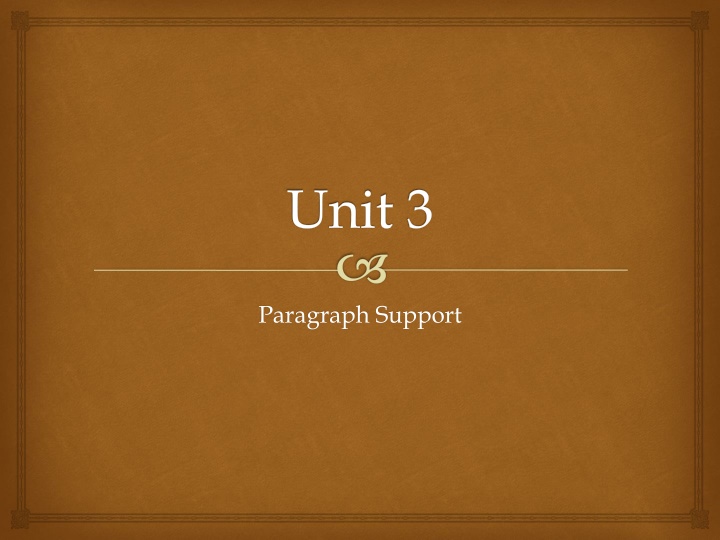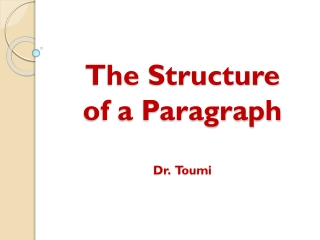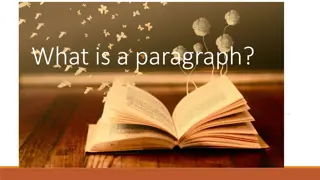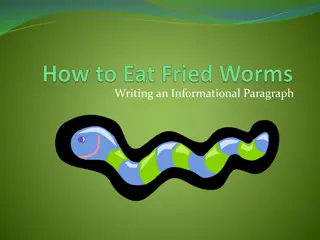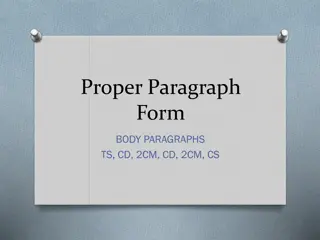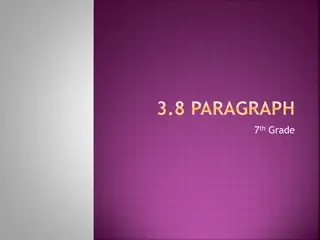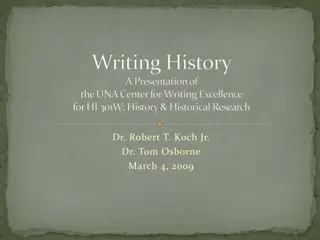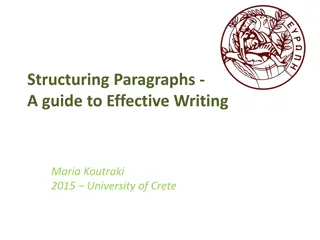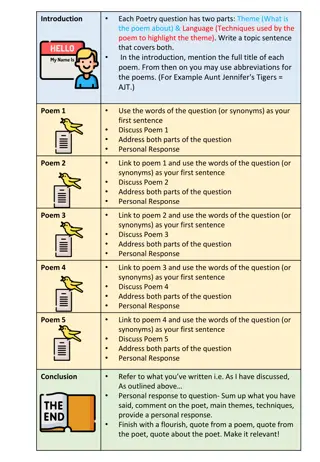Techniques of Paragraph Support
The techniques of paragraph support involve giving details, explanations, examples, anecdotes, and using facts/statistics to assert and demonstrate the main idea effectively. Providing specific points and meaningful explanations can help make your writing more engaging and believable. This comprehensive guide covers various methods to enhance your paragraph development skills.
Download Presentation

Please find below an Image/Link to download the presentation.
The content on the website is provided AS IS for your information and personal use only. It may not be sold, licensed, or shared on other websites without obtaining consent from the author.If you encounter any issues during the download, it is possible that the publisher has removed the file from their server.
You are allowed to download the files provided on this website for personal or commercial use, subject to the condition that they are used lawfully. All files are the property of their respective owners.
The content on the website is provided AS IS for your information and personal use only. It may not be sold, licensed, or shared on other websites without obtaining consent from the author.
E N D
Presentation Transcript
Unit 3 Paragraph Support
Paragraph Support There are five common techniques of support to develop a paragraph: 1. Giving details 2. Giving an explanation 3. Giving example 4. Using anecdotes, i.e., personal experience 5. Using facts and statistics An important point which is inherent in and underlies all of these techniques is asserting and demonstrating.
Asserting and demonstrating: The main idea is usually a general claim and when such a claim is made (i.e., when we assert or tell something), we do not expect others to accept it as it is. Simply telling your reader what you want to communicate may be easy, but it is rarely very interesting or very believable. Demonstrating or showing your reader that the claim you made is valid will make your paragraph more interesting and believable.
Techniques of support: Details Details are specific points that tell more about a general statement. An example: Perhaps it is because of its terrifying and effective teeth that the shark has always been one of the man s most hated and feared enemies. Located beneath its snout, the shark s mouth contains between four and six rows of teeth, but these may number up to twenty-four rows in some species. The teeth are embedded in the gums and gradually move forward as they are used. Eventually, these large teeth drop out and are replaced by new teeth moving from behind them. It is possible for one species of shark to produce up to 24,000 teeth over a ten-year period. This awesome dental equipment produces a jagged crescent-shaped bite.
Techniques of support: Details Another example: Topic Sentence: A newborn baby is really not very beautiful. skin discolored or wrinkled eyes frequently puffy and inflamed shape of head often distorted because of the difficult birth process hair either thick and unruly or nonexistent movements jerky and uncontrolled (muscles not yet developed)
Techniques of support: Explanation An explanation tells what something means or how something works. An example: A stitch in time saves nine. My grandmother, who likes to sew, used this simple saying to teach me the value of working on problems when they are still small. Originally, the saying referred to sewing if you have a small hole in a dress, you can repair it with just one single stitch. But if you wait, the hole will get larger, and it will take you nine stitches. This simple sentence reminds me to take care of small problems before they turn into big ones. a. What is the writer trying to explain? b. Is she successful? Do you understand the explanation? Yes/no
Techniques of support: Explanation An example: (topic sentence) Three important Swiss customs for tourists to know deal with religion, greeting, and punctuality. (subject development) The Swiss people are very religious, and Sunday is their holy day. On Sunday, people rarely work in the garden, in the house, or even on the car. Foreign tourists should know that the most drugstores, supermarkets, and banks are closed on Sunday. The Swiss are also a formal people. For example, they seldom call acquaintances by their first names; the German Herr and French Monsieur are much more frequently used in Switzerland than the English Mister is used in the United States. A tourist should therefore say either Herr or Monsieur when greeting an acquaintance, and only use the person s first name if he is a close friend. In addition, Switzerland is the land of watches and exactness. It is important to be on time to parties, business, meetings, and churches because Swiss hosts, factory bosses, and ministers all love punctuality. It is especially important for tourists to be on time for trains: Swiss train conductors never wait for late arrivers. (summary sentence) In summary, Swiss customs are very easy to follow and very important to remember!
Techniques of support: Example An example is a specific person, place, thing or event that supports an idea or statement How many examples are enough? Depending on the topic, sometimes one would suffice and sometimes several might be needed to support the topic effectively.
Techniques of support: Example An example: Agrarian reform in Venezuela has had positive and negative effects on agriculture. For example, some farmers have obtained loans from the government which they have invested in their land. Many of these farmers have brought tractors to work on their own land. They have cultivated the land very fast. Therefore, they have already obtained benefit from their land, and Venezuela too. But, many farmers have not spent the loan money on their land. Instead, they have bought houses or cars, and the majority have used this money to go to the capital because they want to live there. The result is that many farms are abandoned, and nobody wants to cultivate them.
Techniques of support: Example Another example: Some of the most interesting words in English are the actual names of the people first involved in the activities conveyed by the meanings of the words. The word boycott, for instance, derives from the case of Sir Charles Boycott (1932-97), a land agent in Ireland who was ostracized by his tenants because he refused to lower the rents. Vidkun Quisling s name quickly became an infamous addition to the English language during world war II. He was a Norwegian politician who betrayed his country to the Nazis, and his name, quisling, is now synonymous with traitor. Perhaps a more common example, at least among young people around the world, is Levi s. These popular blue jeans are named after Levi Strauss, the man who first manufactured them in San Francisco in 1850. Perhaps most omnipresent of all is the sandwich, named after the Fourth Earl of Sandwich (1718-92), who created this quick portable meal so that he would not have to leave the gambling table to eat. Other words in this unique category include lynch, watt, davenport, and zeppelin.
Structure of exemplification: There are a number of relatively fixed and easy-to- learn patterns which can be used when it comes to supporting ideas with examples. Some of these patterns are introduced in the following slides.
Structure of exemplification: Pattern 1: Nouns and verb signals showing examples A. Some words in English represent people s names. A good example/illustration of this is the word boycott. B. Some words in English represent people s names. This can be illustrated/exemplified by the word boycott. C. Other words in the category includelynch and boycott.
Structure of exemplification: Pattern 2: Sentence connectors used to show example A. Some English words represent proper names. For example/for instance, the word sandwich originated with Lord Sandwich. B. Some English words represent proper names. The word sandwich, for example/for instance, originated with Lord Sandwich.
Structure of exemplification: Pattern 3: Phrase signals used to show examples A. Words like/such aslynch and quisling represent proper names. B. Such words aslynch and quisling represent proper names. C. Some words represent proper names. Lynch is such a word. Or lynch and quisling are such words.
Techniques of support: Anecdotes By telling the reader a brief story of an actual incident that supports the general statement, you strengthen and support the topic sentence.
Techniques of support: An example for anecdotes why don t I like plays? When I was only 12 years old, there was a play shown about the Algerian revolution during French colonialism. That was a time in my country s history when the French stayed in Algeria for 130 years. the play was written about a true story and was written by a French reporter who lived with the French army in Algeria. The play was about what the French did with the Algerian people until the liberation. In the middle of the play, we saw two French soldiers coming out of a tavern. They went into the street, really drunk. Suddenly they met an Algerian woman who was pregnant. One of them said, I bet she has a baby boy. the other said, No, I swear it is a girl. Then, after an argument, they bet some francs and followed the woman. They caught her, and one of them took a dagger and pushed it into her belly. How cruel it was! I really could not stand the sight, and went out of the theatre, swearing not to see any more plays in my life.
Techniques of support: Another example for anecdotes A film director s style is usually personal and recognizable, but every rule has its exception. Not long ago I was in a theatre watching Roman Polanski s Macbeth. Suddenly the action slowed considerably. A frightening red circle began moving outward from the center of the screen, engulfing first the actors and finally the entire scene. I was sitting on the edge of my seat, waiting for the next horror, which never came. It was not Polanski s terrifying style after all, but a fire in the film projector.
Techniques of support: Facts and statistics Writers sometimes use facts and statistics to support their ideas. A fact is something which is objectively verifiable. A statistic is a numerical fact which presents significant information about a given subject. Of course, facts and statistics should be accurate and relevant; using an authoritative source for your facts and statistics can make your support more believable to your reader.
Facts and statistics: An example Percentages of families using the consumer durables from 1972 to 1983 Consumer durables Central heating 1972 1974 1976 1978 1979 1981 1982 1983 37 43 48 52 55 59 60 64 Television 93 95 96 96 97 97 97 98 18 Video Vacuum cleaner 87 89 92 92 93 94 95 Refrigerator 73 66 81 68 88 71 91 75 92 74 93 78 93 79 94 80 Washing machine Dishwasher 3 3 67 4 75 4 76 5 Telephone 42 50 54 60 77
Facts and statistics: An example As a result of the development of technology and, thereby, the increase in the manufacturing of consumer durables, the percentage of British households with a range of consumer durables steadily increased between 1972 and 1983. The greatest increase was in telephone ownership, rising from 42% in 1972 to 77% in 1983. Next came central heating ownership, rising from 37% of households in 1972 to 64% in 1983. The percentage of household with refrigerator rose 21% over the same period and of those with a washing machine by 14%. Households with vacuum- cleaners, televisions and dishwashers increased by 8%, 5% and 2%, respectively. In 1983, the year of their introduction, 18% of households had a video recorder.
Facts and statistics: Another example The term population explosion is usually applied to the rapid growth of the last three centuries. In the two hundred years from 1650 to 1850, world population doubled and reached its first billion. In the next eighty years, it doubled again, and by 1975, it had doubled once more to a total of 4 billion. By the year 2000, it is estimated that it will exceed 6 billion and possibly approach 7 billion unless there is a major reduction in birth rates or a major increase in death rates.
Techniques of support: Often a topic sentence is supported by more than one technique of support. A writer may use both facts and examples, or both personal experience and physical description. The writer must decide which techniques of support will most effectively demonstrate what the topic sentence asserts. A paragraph must have at least one technique of support; it may have as many as five.
Concluding sentence: The final sentence of a paragraph is called the concluding sentence. It sums up the main points or restates the main idea in a different way. A sentence that sums up the paragraph reminds the reader of what the writer s main idea and supporting points were.
Concluding sentence (cont.): A sentence that restates the main idea should give the same information in a slightly different way, perhaps by using different words or by using a different word order. A concluding sentence should not introduce a new point.
